Abstract
In the Introduction (A) there is a list of unsolved problems concerning the role of the femoral chordotonal organ. A method to solve these problems by measuring the force at the distal end of the tibia during stimulation of the femoral chordotonal organ is described in (B). The step-response in inactive animals (C) is similar to that of the free-moving tibia. After an active movement caused by touching the abdomen the amplitude of the flexion-force is always higher than before. In (D) a method is described to measure the amplification of the control-system in intact animals. With this method it is verified, that the flexion-force produced by a distinct stimulus is higher after active movements caused by touching the abdomen. But this force is lower after spontaneous active movements caused by darkening the room (Fig. 2). Therefore one must assume, that there are two different types of activity: spontaneous activity and activity after a disturbance. In the frequency-response of the inactive animal (F) (Figs. 4 and 5) the amplitude of the force decreases with increasing frequency at a constant amplitude of stimulus. The phase-shift between reaction and stimulus is much smaller than with the free-moving tibia. Therefore, the large phase-shift as well as the strong decrease of the reaction-amplitude near 1 Hz observed in free-moving tibias (1972b) is mainly due to the mechanical attributes of the system. In Section (F) the receptor-apodeme is sinusoidally moved during active movements of intact and decerebrated animals. As with the free-moving tibia no reaction can be observed during active movements at that phase position for which the response occurs in inactive animals. Instead of this “inactive” response there is another response, called “active” with a phase-shift of about 180°. At the end of an active period the “active” and the “inactive” response can be observed simultaneously (Figs. 7 and 10). The amplitude of the “active” response decreases, and the amplitude of the “inactive” response increases from cycle to cycle. In decerebrated animals there are normally several minutes from the exclusively “active” response to the exclusively “inactive” response without a further increase in amplitude. In intact animals this transition takes only a few seconds. Step-stimuli during active movements (G) show, that in active animals stretching the chordotonal organ causes a flexion of the femor-tibia-joint. Releasing the chordotonal organ does not produce any reaction. Moving the receptor-apodeme in active animals influences the contralateral leg significantly only in middle legs (H). These legs tend to move within the same phase position as the stimulated leg. Moving the receptor-apodeme in a middle leg has no influence on the ipsilateral hind leg, but a weak influence on the ipsilateral front leg, which tends to move within the same phase position as the middle leg. In the discussion (I) a hypothesis is presented according to which the “active” response is a mechanism for adapting the leg movement to a surface which suddenly gives way (I 5). The influence on the contralateral middle leg seems to be a part of this mechanism (I 6). This reaction has nothing to do with the coordination of leg movements in walk (I 7). The feed-back systems which control the distance between the body and the walking surface may be inactive during walking (I 8), but those systems which control the forward movement of the body must be active. Since the feed-back system of the “Kniesehnen-reflex” controls predominantly the body-ground-distance it seems likely that it is normally inactive during walking.
Similar content being viewed by others
Literatur
Barnes,W.J., Spirito,C.P., Evoy,W. H.: Nervous control of walking in the crab, Cardisoma guanhumi. II. Role of resistance reflexes in Walking. Z. vergl. Physiol. 76, 16–31 (1972)
Bässler,U.: Proprioreceptoren am Subcoxal- und Femur-Tibia-Gelenk der Stabheuschrecke Carausius morosus und ihre Rolle bei der Wahrnehmung der Schwerkraftrichtung. Kybernetik 2, 168–193 (1965)
Bässler,U.: Zur Regelung der Stellung des Femur-Tibia-Gelenkes bei der Stabheuschrecke Carausius morosus in der Ruhe und im Lauf. Kybernetik 4, 18–26 (1967)
Bässler,U.: Zur Beeinflussung der Bewegungsweise eines Beines von Carausius morosus durch Amputation anderer Beine. Kybernetik 10, 110–114 (1972a)
Bässler,U.: Der „Kniesehnenreflex” bei Carausius morosus: Übergangsfunktion und Frequenzgang. Kybernetik 11, 32–50 (1972b)
Bässler,U.: Der Regelkreis des Kniesehnenreflexes bei der Stabheuschrecke Carausius morosus: Reaktionen auf passive Bewegungen der Tibia. Kybernetik 12, 8–20 (1972c)
Bässler,U.: Zur Steuerung aktiver Bewegungen des Femur-Tibia-Gelenkes der Stabheuschrecke Carausius morosus. Kybernetik 13, 38–53 (1973)
Bässler,U., Cruse,H., Pflüger,H.J.: Der Regelkreis des Kniesehnenreflexes bei der Stabheuschrecke Carausius morosus: Untersuchungen zur Stabilität des Systems im inaktiven Tier. Kybernetik 15, 117–125 (1974)
Pearson,K.G.: Central programming and reflex control of walking in the cockroach. J. exp. Biol. 56, 173–193 (1972)
Pearson,K.G., Iles,J.F.: Nervous mechanisms underlying intersegmental co-ordination of leg movements during walking in the cockroach. J. exp. Biol. 58, 725–744 (1973)
Author information
Authors and Affiliations
Rights and permissions
About this article
Cite this article
Bässler, U. Vom femoralen Chordotonalorgan gesteuerte Reaktionen bei der Stabheuschrecke Carausius morosus: Messung der von der Tibia erzeugten Kraft im aktiven und inaktiven Tier. Kybernetik 16, 213–226 (1974). https://doi.org/10.1007/BF00288981
Received:
Issue Date:
DOI: https://doi.org/10.1007/BF00288981




